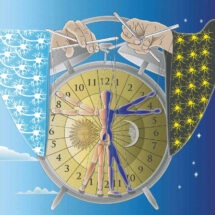
Our daily cycle of sleep and wakefulness – our circadian rhythm – is controlled by a central master clock in our brains: the suprachiasmatic nucleus (SCN). Previously, Michael Hastings’ group in the LMB’s Neurobiology Division had demonstrated that astrocytes were not merely the supporting cells that they had been thought to be, but also had a role in driving the body clock alongside the approximately 10,000 neurons found in the SCN. Building on this work, researchers in Michael’s group have now shown that the astrocytes of the SCN are capable of controlling circadian behaviour in the absence of any input from the neurons of the SCN.
Although many cells in our body contain circadian clocks, these require input and synchronisation from the powerful master clock of the SCN to maintain our daily rhythms. Two main types of cells found in the brain are neurons and glial cells, of which a major part is astrocytes. Until recently, it had been thought that the body clock was entirely driven by neurons and that astrocytes only served as supporting cells to sustain the neurons.
Using microscopic imaging methods, Marco Brancaccio, a researcher in Michael’s group, had previously been able to observe that both neurons and astrocytes of the SCN have a circadian clock, with neurons active during the day and astrocytes active at night, and that this astrocytic clock contributes to the control of the whole body clock. Continuing this project, Marco investigated how important this astrocytic clock might be for circadian behaviour by working with mice that lacked the genes necessary for the clock to function and therefore had arrhythmic behaviour. By restoring the genetic clock only in the astrocytes of the SCN, Michael’s group have now shown that having a working clock mechanism in astrocytes alone is sufficient to drive circadian patterns of behaviour in mice, without the need for any such functioning mechanism in the neurons of the SCN.
Comparison of the mice in which the body clock was driven only by the astrocytes of the SCN to similar mice in which the genetic clock mechanism had only been restored in neurons of the SCN revealed that the animals were on slightly different cycles: astrocyte-driven rhythms were found to be approximately one hour shorter, reflecting the specific cell-autonomous features of the two cell-types.
This work represents a significant change in our understanding of neurobiology and the roles of different cell-types in our brains, and specifically in driving our body clocks. Disturbances of our circadian rhythms are a key feature of many neurological and psychiatric diseases and rotational shift-work causes serious diseases by disrupting the body clock’s control over metabolic and cardiovascular processes. By developing a better understanding of the body clock at this cellular and molecular level in normal physiological function, we will be able to gain a better understanding of how its disruption is associated with disease, which could open the way for new therapeutic interventions.
This work was funded by the MRC.
Further references:
Cell-autonomous clock of astrocytes drives circadian behavior in mammals. Brancaccio, M., Edwards, MD., Patton, AP., Smyllie, NJ., Chesham, JE., Maywood, ES., Hastings, MH. Science
Michael Hastings’ group page
Marco Brancaccio’s group page
Previous Insight on Research: How astrocytes control circadian time-keeping in our principal body clock
Perspective: Many paths to preserve the body clock
MRC press release